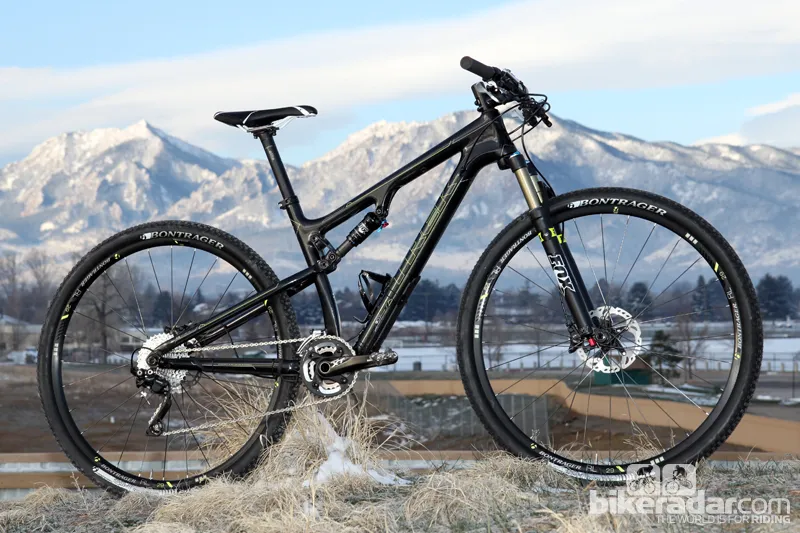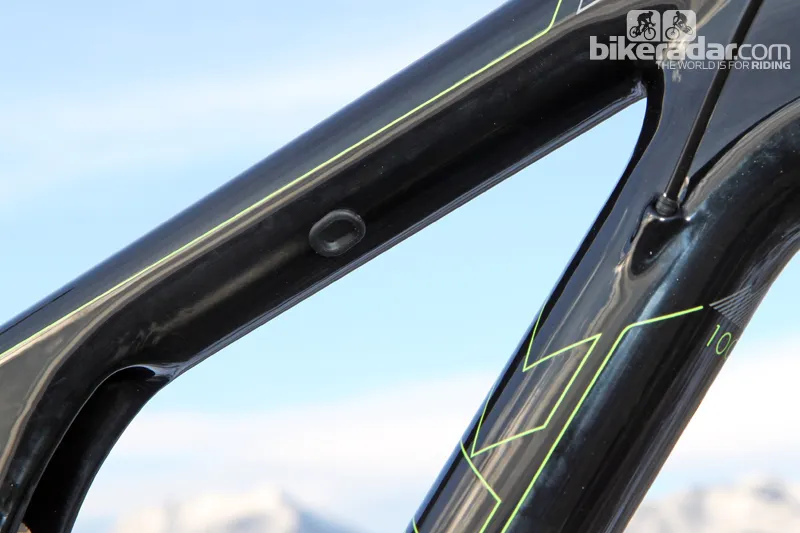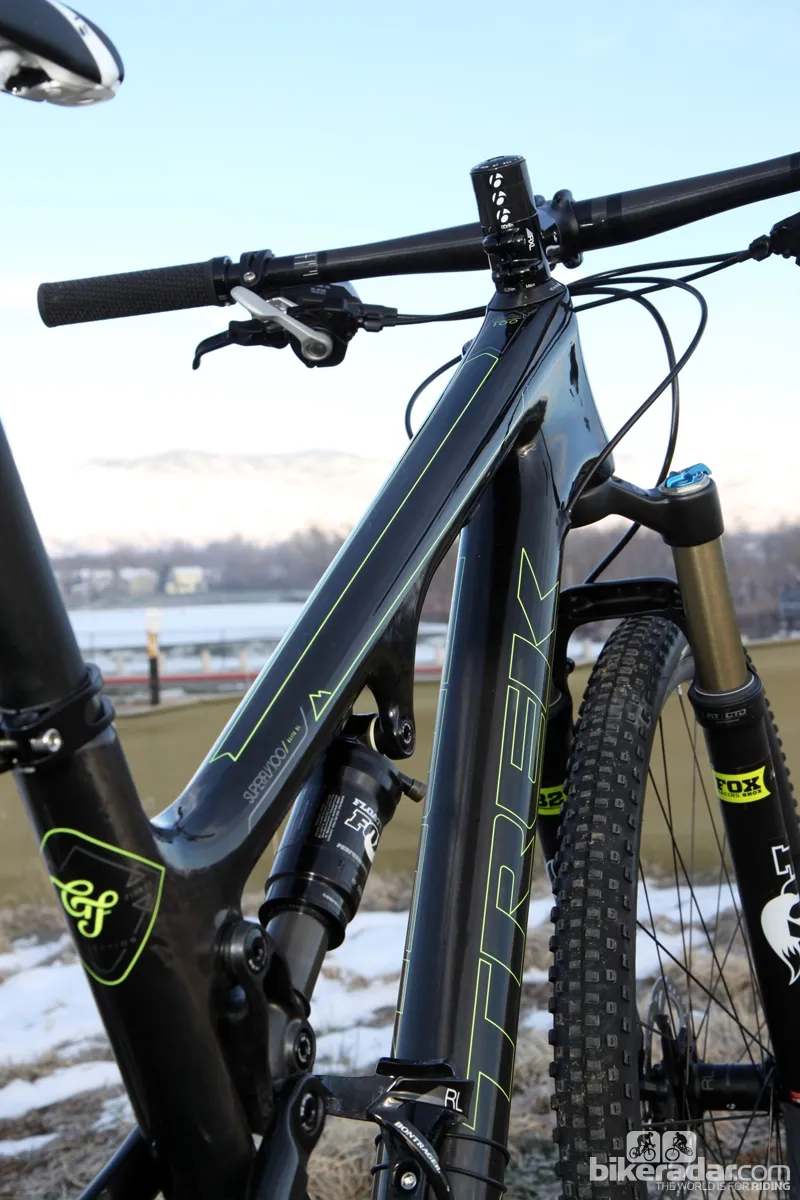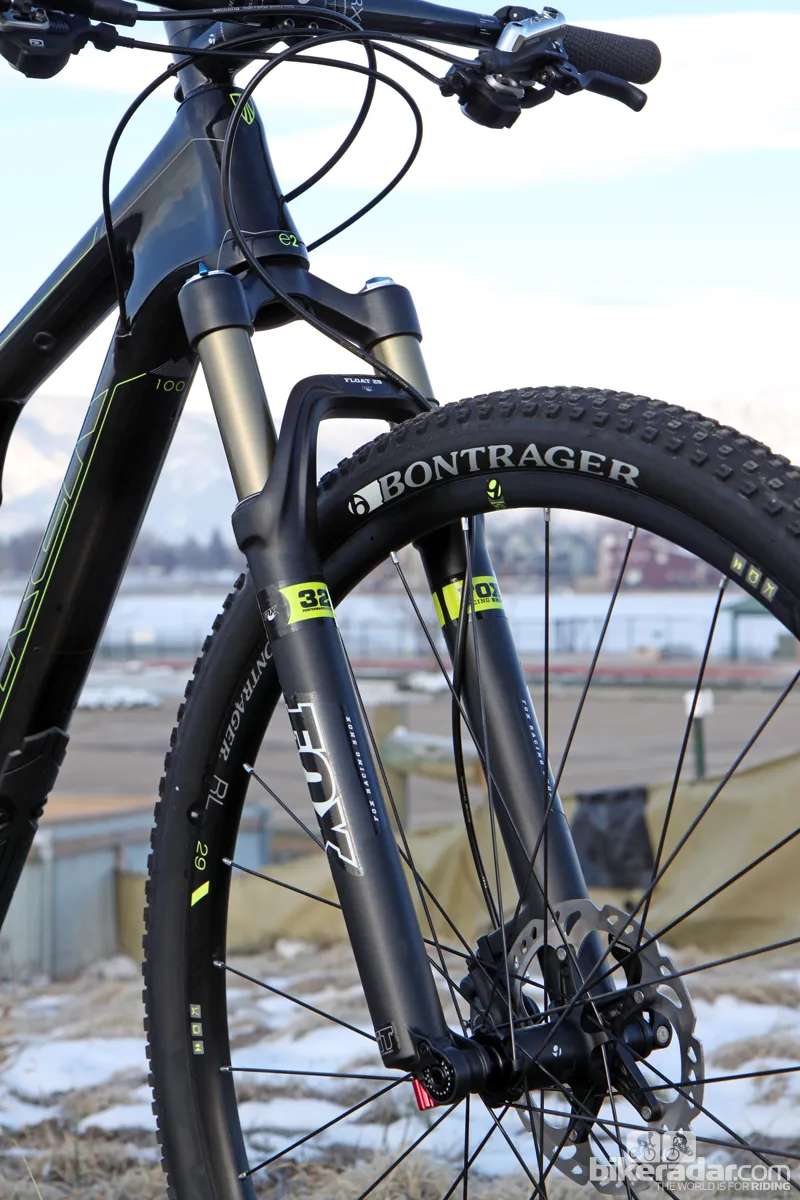Trek set out on an aggressive weight-saving campaign for the latest Superfly 100, and by all accounts its engineering team was largely successful.
Even with a not-incredibly-light Shimano Deore XT group and mid-range wheels, our medium-size Superfly 100 Elite SL test bike weighs just 10.90kg (24.03lb) without pedals. The lack of mass is noticeable on the trail but, unfortunately, so is the lack of stiffness and so-so pedaling performance.
- Pros: Good high-speed geometry; lively rear suspension performance; light weight
- Cons: Not very efficient; not very stiff; very long wheelbase
Ride & handling: Lightweight with good suspension but lacking in efficiency
The revamped Superfly 100 platform feels right at home on fast and flowy trails with lots of wide open, high speed sections.
The long wheelbase and relatively low bottom bracket provide a very stable feel through sweeping corners. And even though it's lost 10mm of movement compared to its predecessor, the remaining 100mm of rear suspension is active and pleasantly progressive, impressively sucking up smaller trail chatter without bottoming out harshly on bigger impacts while maintaining a lively feel throughout.
The rear end offers a good amount of pop for leaping out of berms and dips. And, as we've noted in the past, Trek's G2 geometry, with its increased-offset fork crown, goes a long way towards neutralizing both the big feel of 29in wheels and its unusually long wheelbase.
Steering feels light and natural without requiring much in the way of excessive rider input, and it's usually only in very tight switchbacks that you notice the Superfly 100 Elite SL's considerable overall length.
Like the Giant Anthem X Advanced 29er we tested last year, though, the Superfly 100's chain stays are still a little long at 452mm. Therefore, it's not the most natural bike to manual or wheelie.

Carbon fiber seat stays but aluminum chain stays
Such handling traits would generally be no big deal in the Superfly 100's intended context of cross-country racing, where speeds are usually higher and there often aren't as many technical features as in general trail riding or enduro. However, the Superfly also doesn't pedal that efficiently, either.
Switching the Fox Float CTD rear shock to its middle Trail setting is a must nearly any time pedaling is required, and we frequently resorted to the firmest Climb position even on short sections of fireroad. We saved the fully open Descend setting for extended downhills only. Otherwise, there's far too much movement and a somewhat dull feel under power, particularly when you're hammering along in the big ring.
Nor did we find the Superfly 100 Elite SL's new carbon fiber frame particularly rigid. Front triangle stiffness is admittedly quite good, with the large diameter, nominally round main frame cross-sections and tapered head tube.
That's largely squandered out back, though, with an appreciable amount of out-of-plane flex, particularly in high-load situations such as bermed corners or excessively rough sections of trail. Here, instead of the rear wheel tracking precisely behind the front one, we repeatedly noticed the rear loading up – only to spring back when unloaded, which occasionally sent us off-line.
One simple test verified our suspicions, too: stand beside the Superfly 100 Elite SL with one hand atop the rear tire and the other on the saddle, push forward on one side while pulling back on the other, and you can see the top of the seat stays moving side to side relative to the seat tube more easily than one would expect from a bike of this caliber.
We should note that two BikeRadar testers independently came to identical conclusions on two separate test samples. Naturally, Trek has expressed concern over our findings.
"We're going to be testing that bike to evaluate stiffness testing," said Trek mountain bike brand manager Travis Ott. "I trust you felt what you experienced. Numerous sessions with pros and test riders haven’t exposed any weakness with the rear end stiffness.
"At this point, we’re concerned about repeating what you experienced so we can better figure it out. We’re also retesting stock frames currently. Point being, we take this seriously and when we get conflicting reports, we try and get to the bottom of it.
"As for the suspension spec and pedal bob, four out of five Trek Factory Racing riders also use the same rear shock tune. They wanted a very stiff lockout and we were able to achieve that with this tune. Thus far, the feedback and results from our pro riders have been exceptional. To date, we’ve been happy with the feedback on the bikes from our testers and pros."
Frame: Elegant lines and light weight but could use more brawn
The Superfly 100 Elite SL's performance is particularly disappointing given that the new frame is a gorgeous piece of hardware. The low-slung, molded carbon fiber front triangle features nominally round tubes devoid of superfluous kinks, bulges, or edges, while the one-piece molded carbon fiber seat stay assembly is similarly sleek and clean looking.
As opposed to the original Superfly 100 – or the current Superfly 100 Pro SL flagship model – this version uses TIG-welded aluminum chain stays, which adds some weight but should prove beneficial in terms of long-term durability.
Linking everything together up front is a miniscule swing link – molded from short-strand carbon fiber, of course – driving Fox's superb Float CTD rear shock.
The back end of the bike features Trek's ABP (Active Braking Pivot) concept, with suspension pivots situated concentrically about the rear axle to produce a pseudo-floating brake effect. Those ABP pivots are so cleanly integrated that you could be forgiven for thinking the rear end was one solid unit, although the axle path is strictly single pivot in nature.

The rear end is effectively a single pivot in terms of axle movement
The main pivot is situated inline with the curved seat tube, about halfway between the inner and outer chainrings in terms of height – about where we'd expect it to be. Moving it a touch higher, however, would make for more neutral pedaling performance in the big ring, and add more anti-squat when clawing up grades in the inner ring. Moreover, the Superfly 100 Elite SL's pedaling performance could further benefit from more aggressive compression tuning.
Other features include thru-axles front and rear, Trek's extra-wide BB95 bottom bracket with bearing seats molded directly into the shell, a tapered 1 1/8in to 1 1/2in head tube (again, with bearing seats directly molded in), a direct-mount front derailleur, post-mount rear brake caliper tabs (sized for 140mm rotors and up), and internal cable routing – including for the hydraulic rear brake.
The latter will be cumbersome if you ever decide to swap brake models (although we're not sure why you would – more on that below). Otherwise, though, Trek's internal routing solution is reasonably easy to service despite not being guided from end to end.
Exit ports are fairly large, the paths are clean and kink free, and the whole operation runs impressively quietly, thanks in part to clamps at either end of the brake hose to keep it from rattling around on the trail.

Tiny set screws secure the incoming lines to help reduce rattle
Further dulling sounds is the thick plastic guard on the underside of the down tube. Unfortunately (and rather inelegantly) it's held in place with a couple of giant o-rings.
Actual frame weight for our 17.5in sample is 2.13kg (4.7lb) including rear shock, seatpost collar, rear derailleur hanger, and water bottle bolts – slightly lighter than the previous edition, which is impressive considering the switch to aluminum chain stays. Riders who place a priority on weight will appreciate the lack of heft, but otherwise we'd rather Trek invested the mass currency on bolstering the chassis.
Equipment: Brilliant Deore XT components and Fox suspension plus solid Bontrager gear
There's little to fault when it comes to the Superfly 100 Elite SL's build kit, with Shimano's faultless Deore XT 2x10 transmission and brakes, a perfectly matched Fox 32 Float 100 CTD fork and Float CTD rear shock, and the remainder filled out with bits from Trek house brand Bontrager.
Shift performance is fantastic, with quick and precise chain movement, impressively hushed running, and excellent shifter ergonomics despite the I-Spec integrated clamps' lack of independent shifter angle or shift paddle adjustment. Gear ratios are smartly chosen, too, with versatile 26/38T chainrings up front and a wide-range 11-36T cassette that works well for both racing or general trail riding provided you've got a reasonable amount of fitness.
Unless you've been living under a rock for the past few years, it goes without saying that the matching hydraulic disc brakes are among the best on the market. Power is ample even with just 160mm rotors fitted front and rear, it's very easily controllable even in slippery conditions, and lever feel is arguably second to none.

Deore XT brakes provide heaps of stopping power
Riders in extremely mountainous regions might wish for Shimano's finned brake pads and their greater heat capacity, but we never noticed any fade even on longer descents in Colorado.
We were mostly pleased with the Bontrager cockpit components, too. The Race X Lite Carbon handlebar is suitably light and rigid, with just 5mm of rise to help keep the front end low. However, we would prefer something wider than 690mm for more leverage – it's easy to cut things down if need be but you generally can't make a narrow bar wider.
Ditto for the forged aluminum Race X Lite stem, which is always a solid performer, albeit one whose profile hasn't changed in ages and could stand a larger cross-section in this application.
Saddles are, of course, a personal issue. The Evoke 3 should suit most rear ends with its fairly flat profile and densely padded top with rounded rear corners that help boost maneuverability. We've no complaints on the Rhythm Elite aluminum seatpost, either, with its secure two-bolt head and what should be reliable forged construction.

The Bontrager Evoke 3 saddle is suitably firm and comfy for longer trail rides
Rolling stock is a little more of a mixed bag, though. The Bontrager Race Lite TLR Disc CL 29 wheels are fairly light (1,640g per pair, claimed), easy to set up tubeless (although Trek doesn't include the requisite rim strips and valves), reasonably stiff, and held up well during testing with no truing required. We feel the 19mm internal width is a touch narrow for general trail use, although most cross-country types probably won't mind much.
Bontrager wraps the otherwise-capable wheels with their rather narrowly focused 29-1 tires, though, which don't even measure 2in across and aren't designed to be run tubeless (although we managed the conversion anyway).
Rolling resistance is noticeably very low, but it comes at the price of traction in anything other than tacky dirt, what with its hard rubber compound and tightly spaced array of small knobs. We'd advise at least swapping out the front for something a little more secure and saving the extra one for a spare, fast-rolling rear.




















